Business Analysis Report: Griffith University Learning Management
VerifiedAdded on 2020/03/04
|51
|8326
|41
Report
AI Summary
This business analysis report examines the challenges within Griffith University's Human Activity System for learning management. It identifies the core business problem, which is the difficulty in accessing relevant data and information, impacting students' ability to learn and progress academically. The report includes a detailed stakeholder analysis, outlining roles and responsibilities, attitude and influence, and relationships. It uses various analytical tools such as SWOT and PEST analyses to assess the internal and external factors affecting the system, along with Value Chain and Force Field analyses. The report also addresses business goals and objectives, desired outcomes, and proposes a change strategy with potential benefits and risk assessments. Appendices provide additional supporting information through various diagrams, matrices, and analyses, including SMART objectives, RACI matrix, and MoSCoW analysis, offering a comprehensive view of the issues and potential solutions within the university's learning management framework.
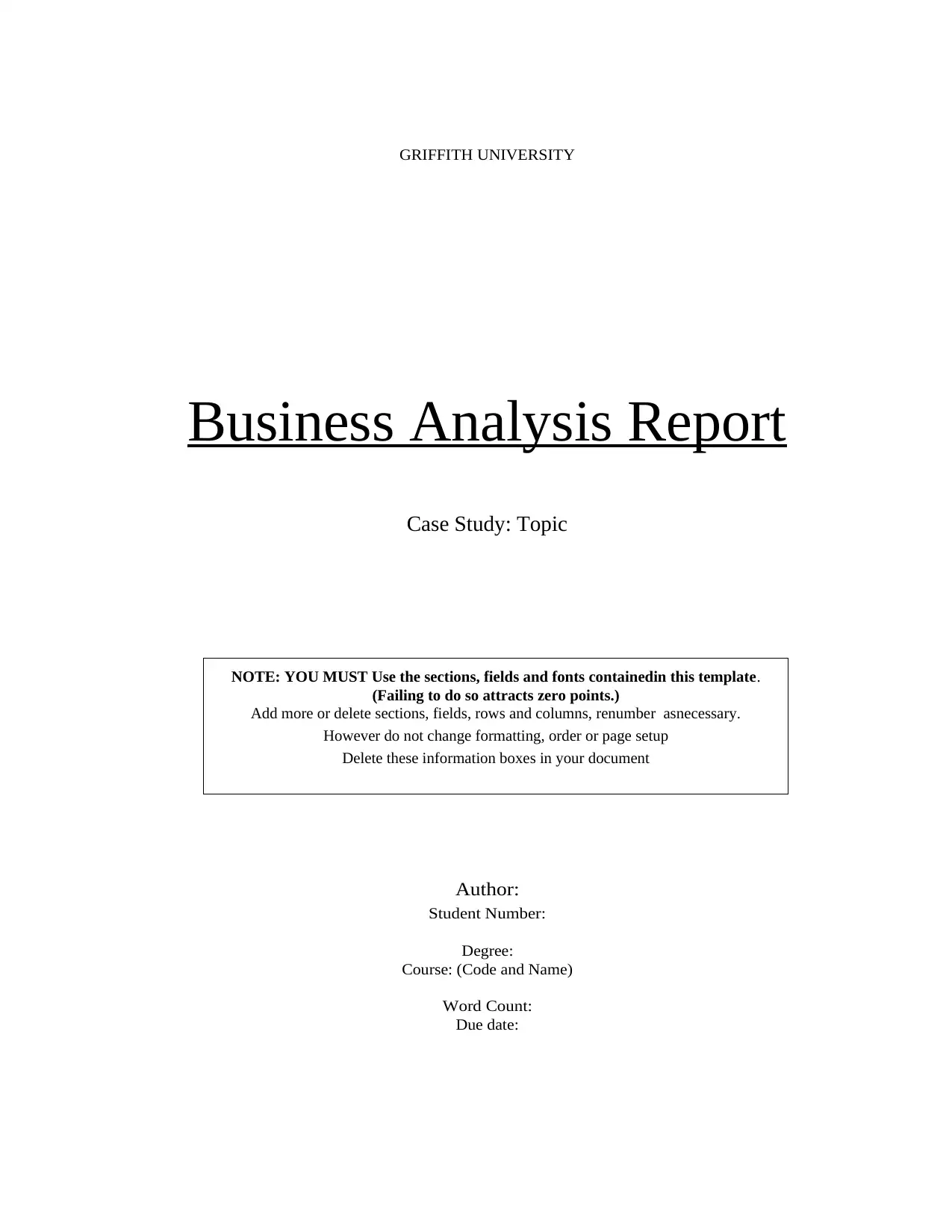
GRIFFITH UNIVERSITY
Business Analysis Report
Case Study: Topic
Author:
Student Number:
Degree:
Course: (Code and Name)
Word Count:
Due date:
NOTE: YOU MUST Use the sections, fields and fonts containedin this template.
(Failing to do so attracts zero points.)
Add more or delete sections, fields, rows and columns, renumber asnecessary.
However do not change formatting, order or page setup
Delete these information boxes in your document
Business Analysis Report
Case Study: Topic
Author:
Student Number:
Degree:
Course: (Code and Name)
Word Count:
Due date:
NOTE: YOU MUST Use the sections, fields and fonts containedin this template.
(Failing to do so attracts zero points.)
Add more or delete sections, fields, rows and columns, renumber asnecessary.
However do not change formatting, order or page setup
Delete these information boxes in your document
Paraphrase This Document
Need a fresh take? Get an instant paraphrase of this document with our AI Paraphraser
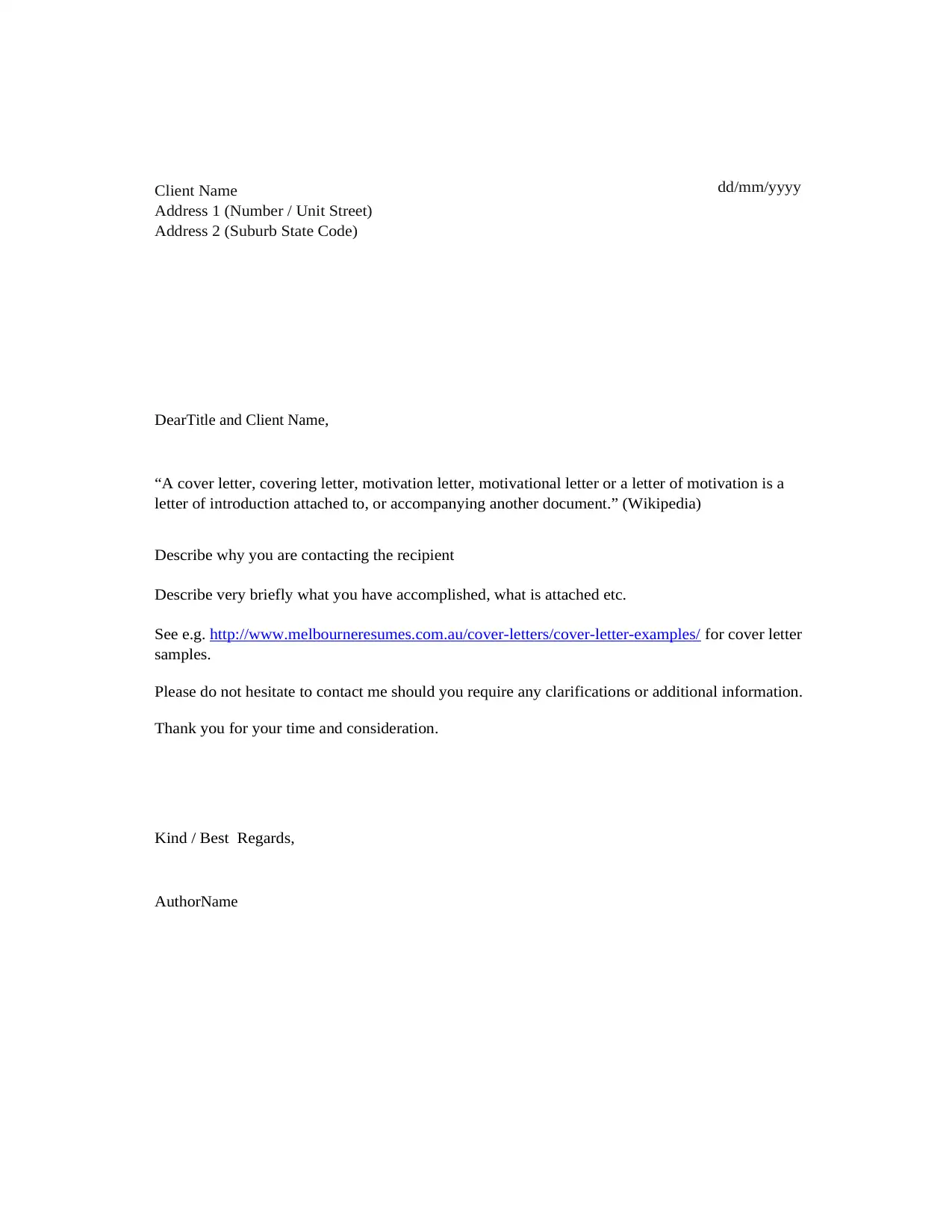
Client Name
Address 1 (Number / Unit Street)
Address 2 (Suburb State Code)
DearTitle and Client Name ,
“A cover letter, covering letter, motivation letter, motivational letter or a letter of motivation is a
letter of introduction attached to, or accompanying another document.” (Wikipedia)
Describe why you are contacting the recipient
Describe very briefly what you have accomplished, what is attached etc.
See e.g. http://www.melbourneresumes.com.au/cover-letters/cover-letter-examples/ for cover letter
samples.
Please do not hesitate to contact me should you require any clarifications or additional information.
Thank you for your time and consideration.
Kind / Best Regards,
AuthorName
dd/mm/yyyy
Address 1 (Number / Unit Street)
Address 2 (Suburb State Code)
DearTitle and Client Name ,
“A cover letter, covering letter, motivation letter, motivational letter or a letter of motivation is a
letter of introduction attached to, or accompanying another document.” (Wikipedia)
Describe why you are contacting the recipient
Describe very briefly what you have accomplished, what is attached etc.
See e.g. http://www.melbourneresumes.com.au/cover-letters/cover-letter-examples/ for cover letter
samples.
Please do not hesitate to contact me should you require any clarifications or additional information.
Thank you for your time and consideration.
Kind / Best Regards,
AuthorName
dd/mm/yyyy
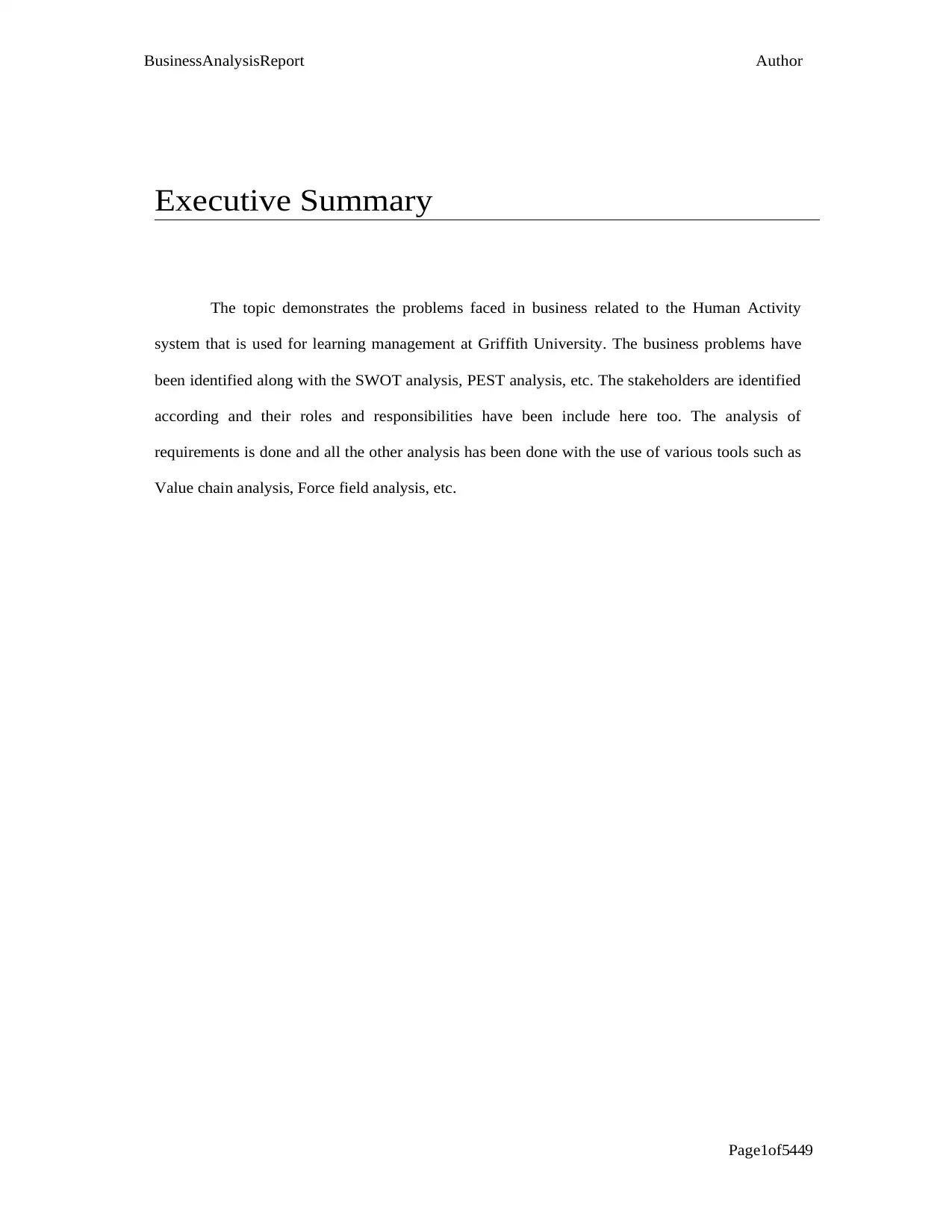
Page1of5449
BusinessAnalysisReport Author
Executive Summary
The topic demonstrates the problems faced in business related to the Human Activity
system that is used for learning management at Griffith University. The business problems have
been identified along with the SWOT analysis, PEST analysis, etc. The stakeholders are identified
according and their roles and responsibilities have been include here too. The analysis of
requirements is done and all the other analysis has been done with the use of various tools such as
Value chain analysis, Force field analysis, etc.
BusinessAnalysisReport Author
Executive Summary
The topic demonstrates the problems faced in business related to the Human Activity
system that is used for learning management at Griffith University. The business problems have
been identified along with the SWOT analysis, PEST analysis, etc. The stakeholders are identified
according and their roles and responsibilities have been include here too. The analysis of
requirements is done and all the other analysis has been done with the use of various tools such as
Value chain analysis, Force field analysis, etc.
⊘ This is a preview!⊘
Do you want full access?
Subscribe today to unlock all pages.

Trusted by 1+ million students worldwide
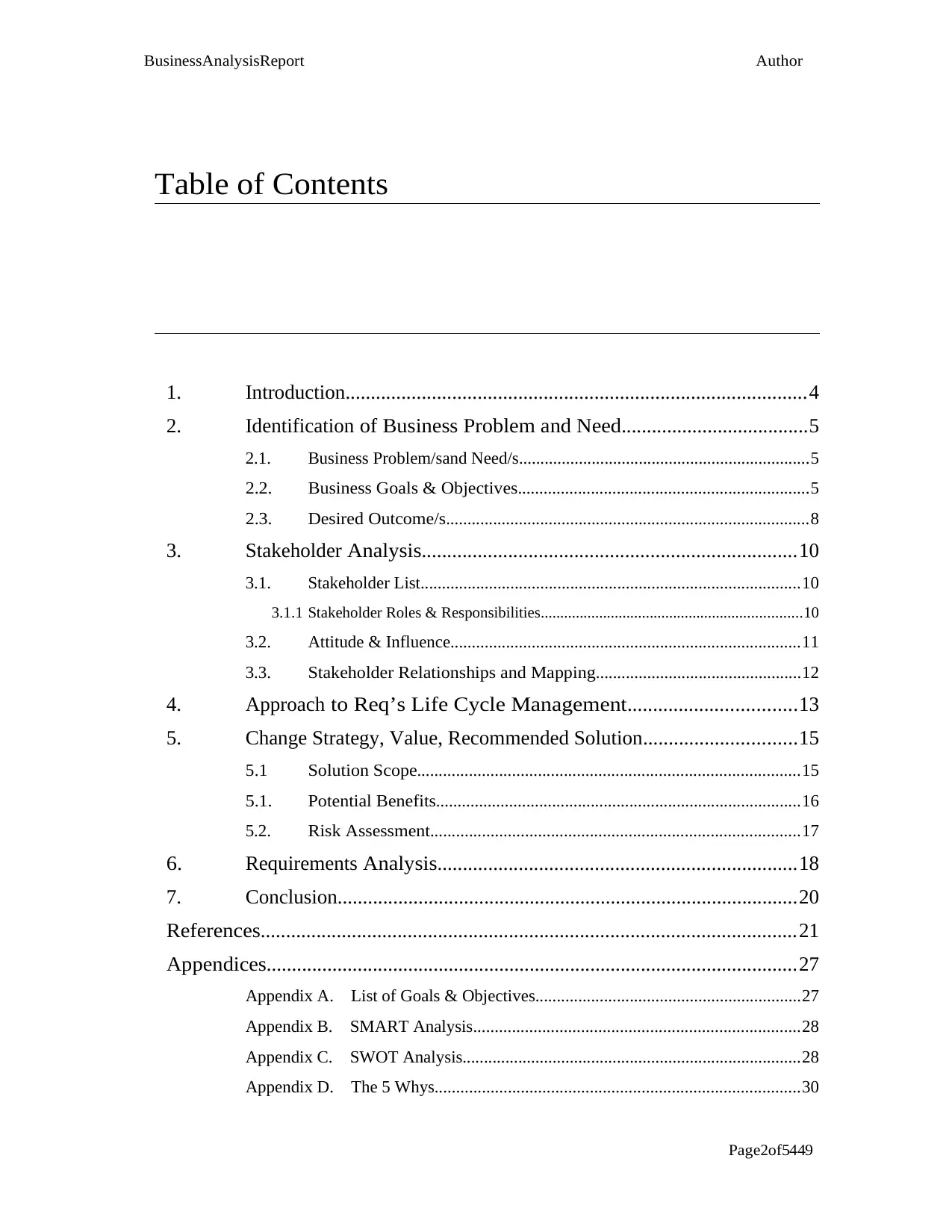
BusinessAnalysisReport Author
Page2of5449
Table of Contents
1. Introduction...........................................................................................4
2. Identification of Business Problem and Need.....................................5
2.1. Business Problem/sand Need/s....................................................................5
2.2. Business Goals & Objectives....................................................................5
2.3. Desired Outcome/s.....................................................................................8
3. Stakeholder Analysis..........................................................................10
3.1. Stakeholder List.........................................................................................10
3.1.1 Stakeholder Roles & Responsibilities...................................................................10
3.2. Attitude & Influence..................................................................................11
3.3. Stakeholder Relationships and Mapping................................................12
4. Approach to Req’s Life Cycle Management.................................13
5. Change Strategy, Value, Recommended Solution..............................15
5.1 Solution Scope.........................................................................................15
5.1. Potential Benefits.....................................................................................16
5.2. Risk Assessment......................................................................................17
6. Requirements Analysis.......................................................................18
7. Conclusion...........................................................................................20
References..........................................................................................................21
Appendices.........................................................................................................27
Appendix A. List of Goals & Objectives..............................................................27
Appendix B. SMART Analysis............................................................................28
Appendix C. SWOT Analysis...............................................................................28
Appendix D. The 5 Whys.....................................................................................30
Page2of5449
Table of Contents
1. Introduction...........................................................................................4
2. Identification of Business Problem and Need.....................................5
2.1. Business Problem/sand Need/s....................................................................5
2.2. Business Goals & Objectives....................................................................5
2.3. Desired Outcome/s.....................................................................................8
3. Stakeholder Analysis..........................................................................10
3.1. Stakeholder List.........................................................................................10
3.1.1 Stakeholder Roles & Responsibilities...................................................................10
3.2. Attitude & Influence..................................................................................11
3.3. Stakeholder Relationships and Mapping................................................12
4. Approach to Req’s Life Cycle Management.................................13
5. Change Strategy, Value, Recommended Solution..............................15
5.1 Solution Scope.........................................................................................15
5.1. Potential Benefits.....................................................................................16
5.2. Risk Assessment......................................................................................17
6. Requirements Analysis.......................................................................18
7. Conclusion...........................................................................................20
References..........................................................................................................21
Appendices.........................................................................................................27
Appendix A. List of Goals & Objectives..............................................................27
Appendix B. SMART Analysis............................................................................28
Appendix C. SWOT Analysis...............................................................................28
Appendix D. The 5 Whys.....................................................................................30
Paraphrase This Document
Need a fresh take? Get an instant paraphrase of this document with our AI Paraphraser
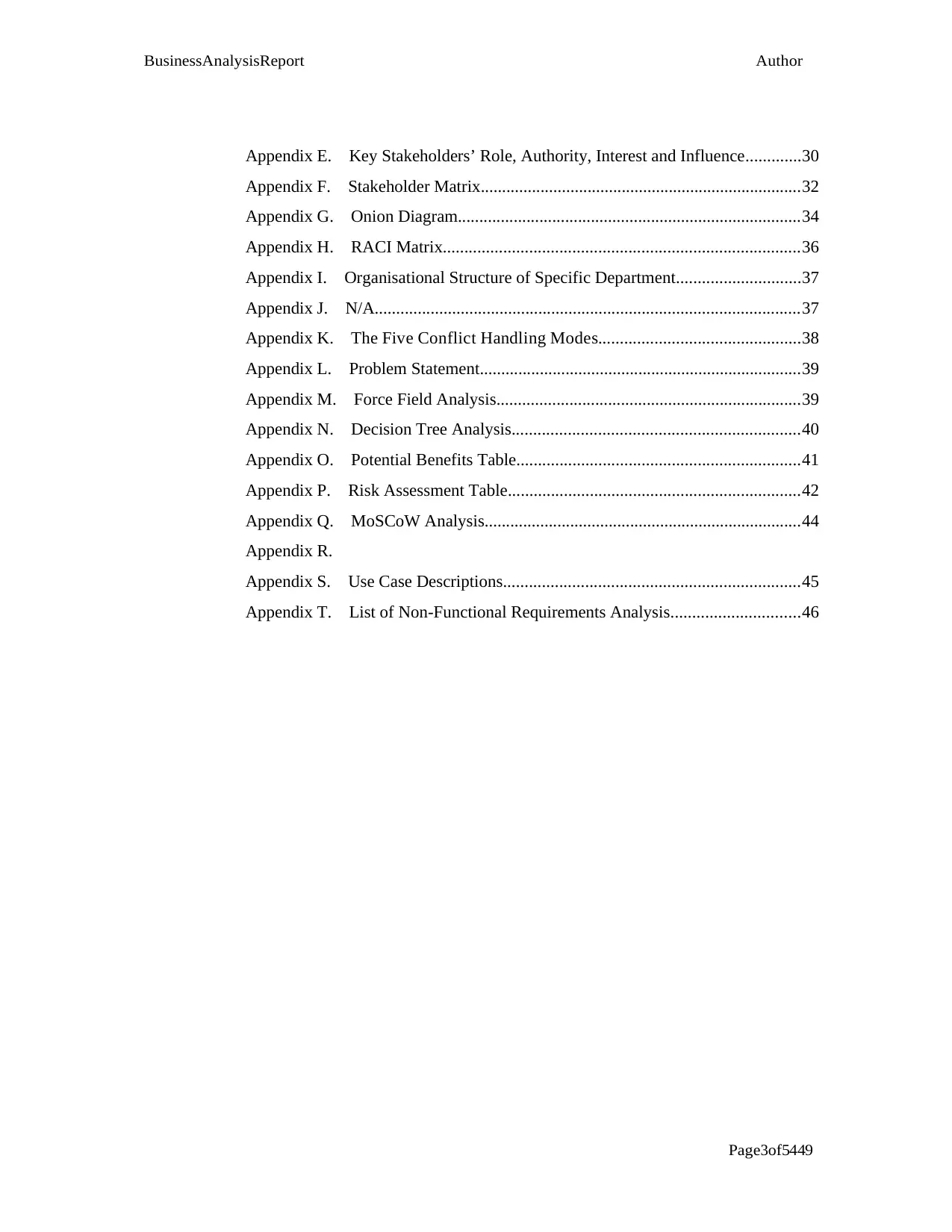
BusinessAnalysisReport Author
Page3of5449
Appendix E. Key Stakeholders’ Role, Authority, Interest and Influence.............30
Appendix F. Stakeholder Matrix...........................................................................32
Appendix G. Onion Diagram................................................................................34
Appendix H. RACI Matrix...................................................................................36
Appendix I. Organisational Structure of Specific Department.............................37
Appendix J. N/A...................................................................................................37
Appendix K. The Five Conflict Handling Modes...............................................38
Appendix L. Problem Statement...........................................................................39
Appendix M. Force Field Analysis.......................................................................39
Appendix N. Decision Tree Analysis...................................................................40
Appendix O. Potential Benefits Table..................................................................41
Appendix P. Risk Assessment Table....................................................................42
Appendix Q. MoSCoW Analysis..........................................................................44
Appendix R.
Appendix S. Use Case Descriptions.....................................................................45
Appendix T. List of Non-Functional Requirements Analysis..............................46
Page3of5449
Appendix E. Key Stakeholders’ Role, Authority, Interest and Influence.............30
Appendix F. Stakeholder Matrix...........................................................................32
Appendix G. Onion Diagram................................................................................34
Appendix H. RACI Matrix...................................................................................36
Appendix I. Organisational Structure of Specific Department.............................37
Appendix J. N/A...................................................................................................37
Appendix K. The Five Conflict Handling Modes...............................................38
Appendix L. Problem Statement...........................................................................39
Appendix M. Force Field Analysis.......................................................................39
Appendix N. Decision Tree Analysis...................................................................40
Appendix O. Potential Benefits Table..................................................................41
Appendix P. Risk Assessment Table....................................................................42
Appendix Q. MoSCoW Analysis..........................................................................44
Appendix R.
Appendix S. Use Case Descriptions.....................................................................45
Appendix T. List of Non-Functional Requirements Analysis..............................46
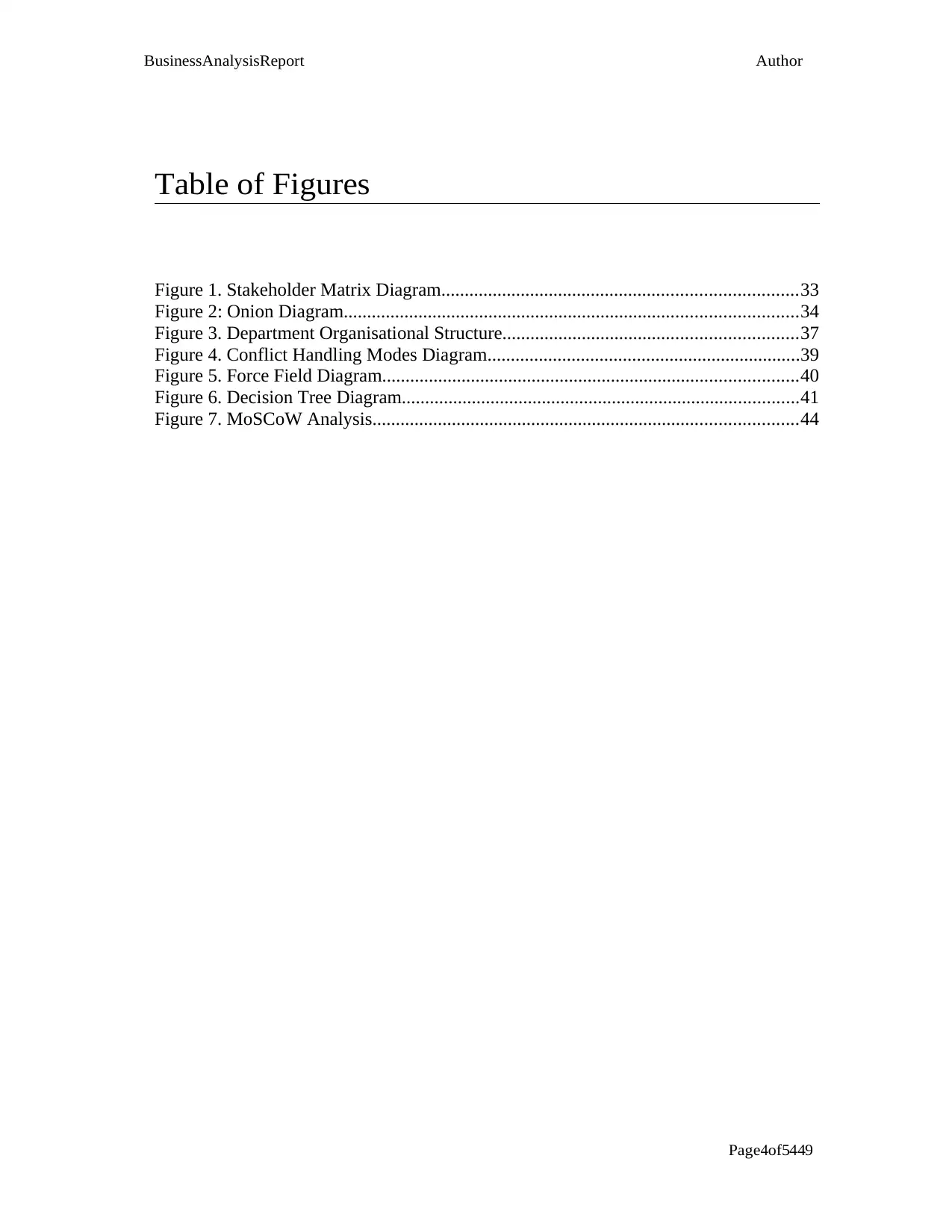
BusinessAnalysisReport Author
Page4of5449
Table of Figures
Figure 1. Stakeholder Matrix Diagram............................................................................33
Figure 2: Onion Diagram.................................................................................................34
Figure 3. Department Organisational Structure...............................................................37
Figure 4. Conflict Handling Modes Diagram...................................................................39
Figure 5. Force Field Diagram.........................................................................................40
Figure 6. Decision Tree Diagram.....................................................................................41
Figure 7. MoSCoW Analysis...........................................................................................44
Page4of5449
Table of Figures
Figure 1. Stakeholder Matrix Diagram............................................................................33
Figure 2: Onion Diagram.................................................................................................34
Figure 3. Department Organisational Structure...............................................................37
Figure 4. Conflict Handling Modes Diagram...................................................................39
Figure 5. Force Field Diagram.........................................................................................40
Figure 6. Decision Tree Diagram.....................................................................................41
Figure 7. MoSCoW Analysis...........................................................................................44
⊘ This is a preview!⊘
Do you want full access?
Subscribe today to unlock all pages.

Trusted by 1+ million students worldwide
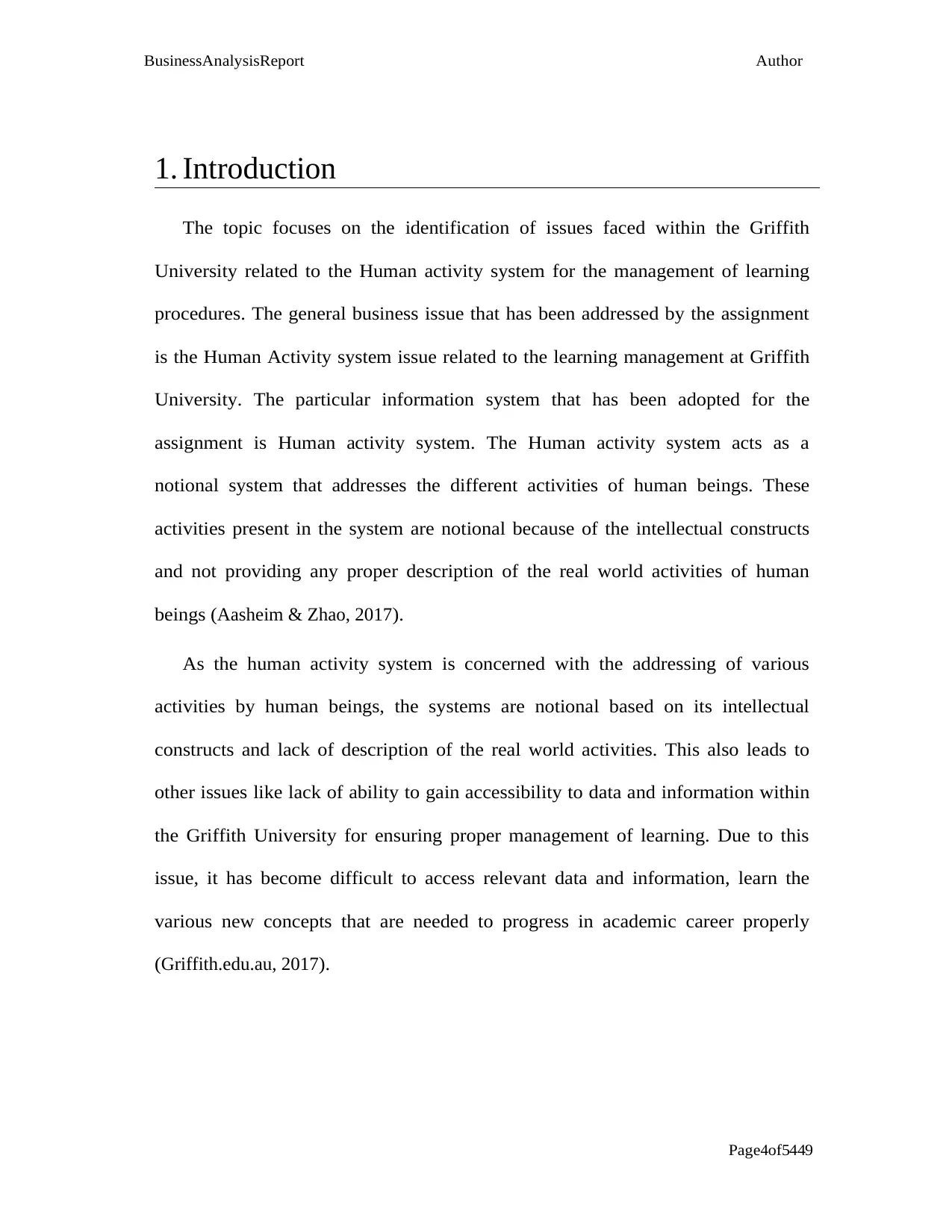
BusinessAnalysisReport Author
Page4of5449
1. Introduction
The topic focuses on the identification of issues faced within the Griffith
University related to the Human activity system for the management of learning
procedures. The general business issue that has been addressed by the assignment
is the Human Activity system issue related to the learning management at Griffith
University. The particular information system that has been adopted for the
assignment is Human activity system. The Human activity system acts as a
notional system that addresses the different activities of human beings. These
activities present in the system are notional because of the intellectual constructs
and not providing any proper description of the real world activities of human
beings (Aasheim & Zhao, 2017 ).
As the human activity system is concerned with the addressing of various
activities by human beings, the systems are notional based on its intellectual
constructs and lack of description of the real world activities. This also leads to
other issues like lack of ability to gain accessibility to data and information within
the Griffith University for ensuring proper management of learning. Due to this
issue, it has become difficult to access relevant data and information, learn the
various new concepts that are needed to progress in academic career properly
(Griffith.edu.au, 2017 ).
Page4of5449
1. Introduction
The topic focuses on the identification of issues faced within the Griffith
University related to the Human activity system for the management of learning
procedures. The general business issue that has been addressed by the assignment
is the Human Activity system issue related to the learning management at Griffith
University. The particular information system that has been adopted for the
assignment is Human activity system. The Human activity system acts as a
notional system that addresses the different activities of human beings. These
activities present in the system are notional because of the intellectual constructs
and not providing any proper description of the real world activities of human
beings (Aasheim & Zhao, 2017 ).
As the human activity system is concerned with the addressing of various
activities by human beings, the systems are notional based on its intellectual
constructs and lack of description of the real world activities. This also leads to
other issues like lack of ability to gain accessibility to data and information within
the Griffith University for ensuring proper management of learning. Due to this
issue, it has become difficult to access relevant data and information, learn the
various new concepts that are needed to progress in academic career properly
(Griffith.edu.au, 2017 ).
Paraphrase This Document
Need a fresh take? Get an instant paraphrase of this document with our AI Paraphraser
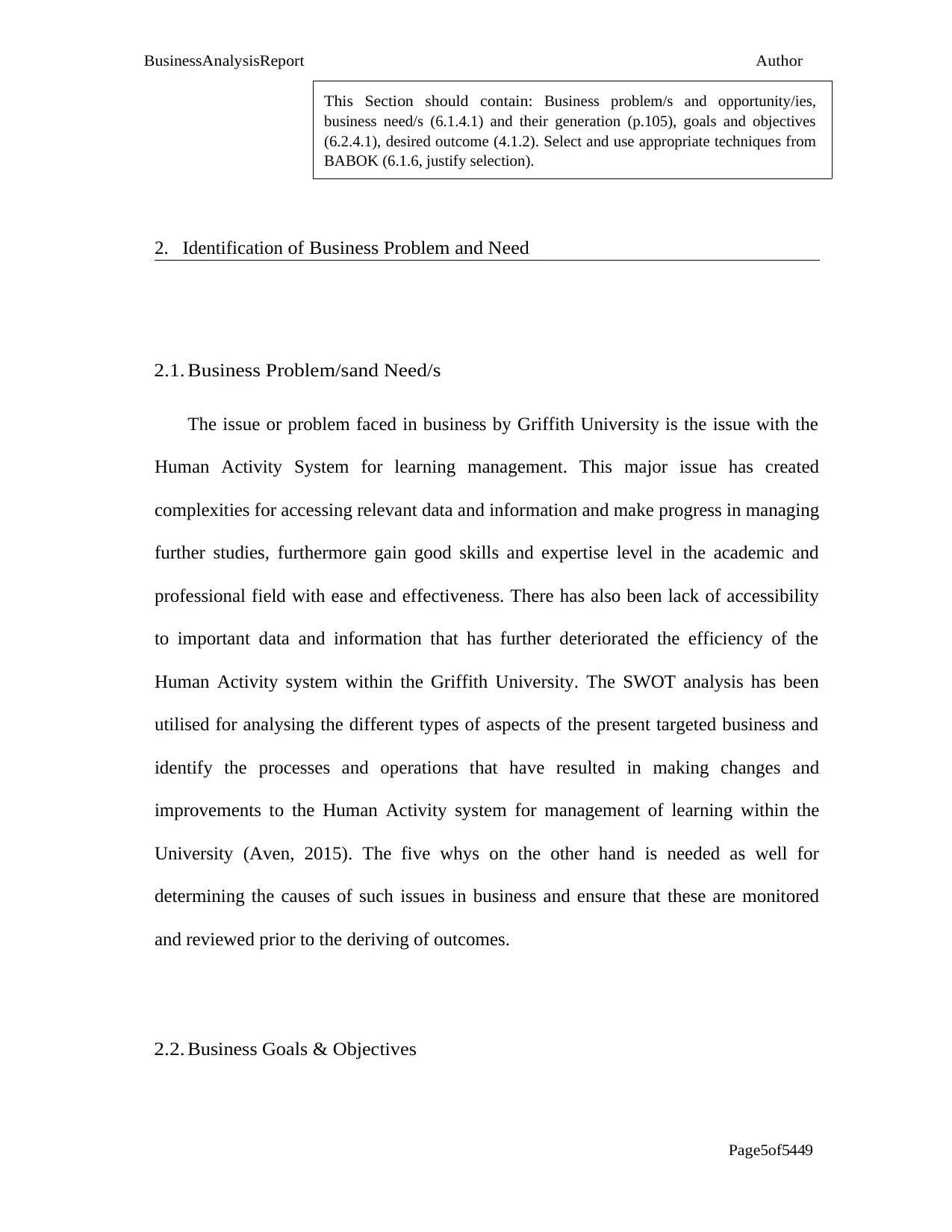
BusinessAnalysisReport Author
Page5of5449
2. Identification of Business Problem and Need
2.1. Business Problem/sand Need/s
The issue or problem faced in business by Griffith University is the issue with the
Human Activity System for learning management. This major issue has created
complexities for accessing relevant data and information and make progress in managing
further studies, furthermore gain good skills and expertise level in the academic and
professional field with ease and effectiveness. There has also been lack of accessibility
to important data and information that has further deteriorated the efficiency of the
Human Activity system within the Griffith University. The SWOT analysis has been
utilised for analysing the different types of aspects of the present targeted business and
identify the processes and operations that have resulted in making changes and
improvements to the Human Activity system for management of learning within the
University (Aven, 2015). The five whys on the other hand is needed as well for
determining the causes of such issues in business and ensure that these are monitored
and reviewed prior to the deriving of outcomes.
2.2. Business Goals & Objectives
This Section should contain: Business problem/s and opportunity/ies,
business need/s (6.1.4.1) and their generation (p.105), goals and objectives
(6.2.4.1), desired outcome (4.1.2). Select and use appropriate techniques from
BABOK (6.1.6, justify selection).
Page5of5449
2. Identification of Business Problem and Need
2.1. Business Problem/sand Need/s
The issue or problem faced in business by Griffith University is the issue with the
Human Activity System for learning management. This major issue has created
complexities for accessing relevant data and information and make progress in managing
further studies, furthermore gain good skills and expertise level in the academic and
professional field with ease and effectiveness. There has also been lack of accessibility
to important data and information that has further deteriorated the efficiency of the
Human Activity system within the Griffith University. The SWOT analysis has been
utilised for analysing the different types of aspects of the present targeted business and
identify the processes and operations that have resulted in making changes and
improvements to the Human Activity system for management of learning within the
University (Aven, 2015). The five whys on the other hand is needed as well for
determining the causes of such issues in business and ensure that these are monitored
and reviewed prior to the deriving of outcomes.
2.2. Business Goals & Objectives
This Section should contain: Business problem/s and opportunity/ies,
business need/s (6.1.4.1) and their generation (p.105), goals and objectives
(6.2.4.1), desired outcome (4.1.2). Select and use appropriate techniques from
BABOK (6.1.6, justify selection).
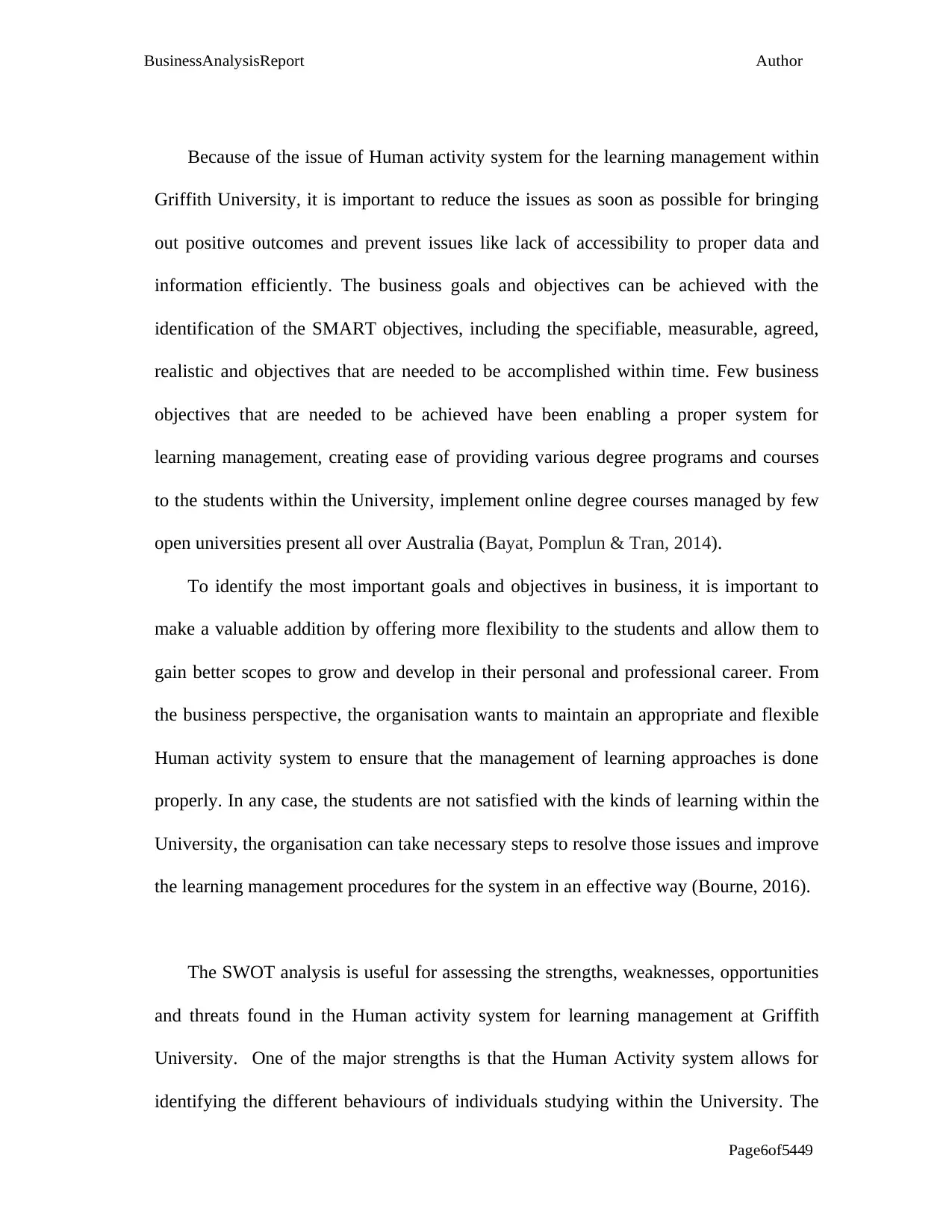
BusinessAnalysisReport Author
Page6of5449
Because of the issue of Human activity system for the learning management within
Griffith University, it is important to reduce the issues as soon as possible for bringing
out positive outcomes and prevent issues like lack of accessibility to proper data and
information efficiently. The business goals and objectives can be achieved with the
identification of the SMART objectives, including the specifiable, measurable, agreed,
realistic and objectives that are needed to be accomplished within time. Few business
objectives that are needed to be achieved have been enabling a proper system for
learning management, creating ease of providing various degree programs and courses
to the students within the University, implement online degree courses managed by few
open universities present all over Australia (Bayat, Pomplun & Tran, 2014).
To identify the most important goals and objectives in business, it is important to
make a valuable addition by offering more flexibility to the students and allow them to
gain better scopes to grow and develop in their personal and professional career. From
the business perspective, the organisation wants to maintain an appropriate and flexible
Human activity system to ensure that the management of learning approaches is done
properly. In any case, the students are not satisfied with the kinds of learning within the
University, the organisation can take necessary steps to resolve those issues and improve
the learning management procedures for the system in an effective way (Bourne, 2016).
The SWOT analysis is useful for assessing the strengths, weaknesses, opportunities
and threats found in the Human activity system for learning management at Griffith
University. One of the major strengths is that the Human Activity system allows for
identifying the different behaviours of individuals studying within the University. The
Page6of5449
Because of the issue of Human activity system for the learning management within
Griffith University, it is important to reduce the issues as soon as possible for bringing
out positive outcomes and prevent issues like lack of accessibility to proper data and
information efficiently. The business goals and objectives can be achieved with the
identification of the SMART objectives, including the specifiable, measurable, agreed,
realistic and objectives that are needed to be accomplished within time. Few business
objectives that are needed to be achieved have been enabling a proper system for
learning management, creating ease of providing various degree programs and courses
to the students within the University, implement online degree courses managed by few
open universities present all over Australia (Bayat, Pomplun & Tran, 2014).
To identify the most important goals and objectives in business, it is important to
make a valuable addition by offering more flexibility to the students and allow them to
gain better scopes to grow and develop in their personal and professional career. From
the business perspective, the organisation wants to maintain an appropriate and flexible
Human activity system to ensure that the management of learning approaches is done
properly. In any case, the students are not satisfied with the kinds of learning within the
University, the organisation can take necessary steps to resolve those issues and improve
the learning management procedures for the system in an effective way (Bourne, 2016).
The SWOT analysis is useful for assessing the strengths, weaknesses, opportunities
and threats found in the Human activity system for learning management at Griffith
University. One of the major strengths is that the Human Activity system allows for
identifying the different behaviours of individuals studying within the University. The
⊘ This is a preview!⊘
Do you want full access?
Subscribe today to unlock all pages.

Trusted by 1+ million students worldwide
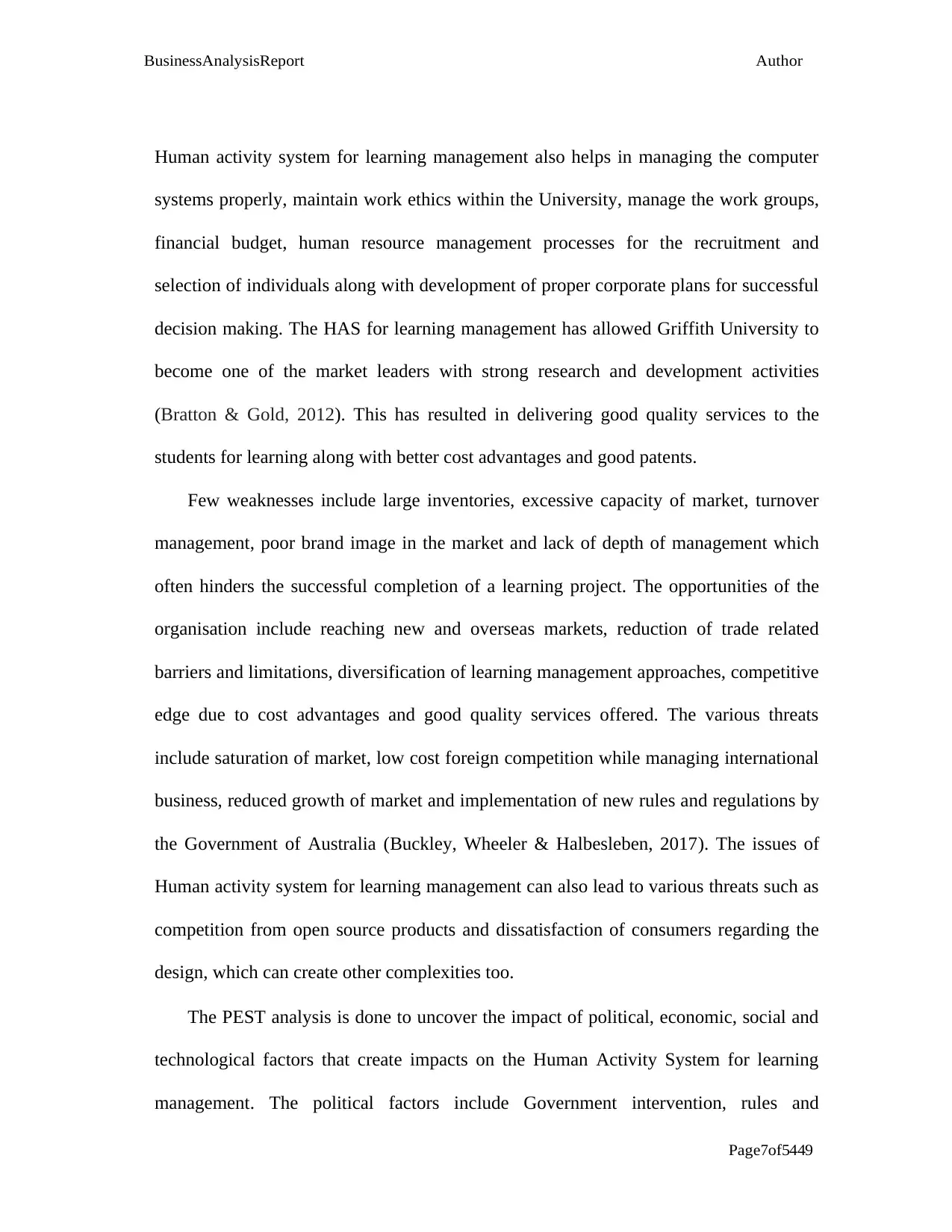
BusinessAnalysisReport Author
Page7of5449
Human activity system for learning management also helps in managing the computer
systems properly, maintain work ethics within the University, manage the work groups,
financial budget, human resource management processes for the recruitment and
selection of individuals along with development of proper corporate plans for successful
decision making. The HAS for learning management has allowed Griffith University to
become one of the market leaders with strong research and development activities
(Bratton & Gold, 2012). This has resulted in delivering good quality services to the
students for learning along with better cost advantages and good patents.
Few weaknesses include large inventories, excessive capacity of market, turnover
management, poor brand image in the market and lack of depth of management which
often hinders the successful completion of a learning project. The opportunities of the
organisation include reaching new and overseas markets, reduction of trade related
barriers and limitations, diversification of learning management approaches, competitive
edge due to cost advantages and good quality services offered. The various threats
include saturation of market, low cost foreign competition while managing international
business, reduced growth of market and implementation of new rules and regulations by
the Government of Australia (Buckley, Wheeler & Halbesleben, 2017). The issues of
Human activity system for learning management can also lead to various threats such as
competition from open source products and dissatisfaction of consumers regarding the
design, which can create other complexities too.
The PEST analysis is done to uncover the impact of political, economic, social and
technological factors that create impacts on the Human Activity System for learning
management. The political factors include Government intervention, rules and
Page7of5449
Human activity system for learning management also helps in managing the computer
systems properly, maintain work ethics within the University, manage the work groups,
financial budget, human resource management processes for the recruitment and
selection of individuals along with development of proper corporate plans for successful
decision making. The HAS for learning management has allowed Griffith University to
become one of the market leaders with strong research and development activities
(Bratton & Gold, 2012). This has resulted in delivering good quality services to the
students for learning along with better cost advantages and good patents.
Few weaknesses include large inventories, excessive capacity of market, turnover
management, poor brand image in the market and lack of depth of management which
often hinders the successful completion of a learning project. The opportunities of the
organisation include reaching new and overseas markets, reduction of trade related
barriers and limitations, diversification of learning management approaches, competitive
edge due to cost advantages and good quality services offered. The various threats
include saturation of market, low cost foreign competition while managing international
business, reduced growth of market and implementation of new rules and regulations by
the Government of Australia (Buckley, Wheeler & Halbesleben, 2017). The issues of
Human activity system for learning management can also lead to various threats such as
competition from open source products and dissatisfaction of consumers regarding the
design, which can create other complexities too.
The PEST analysis is done to uncover the impact of political, economic, social and
technological factors that create impacts on the Human Activity System for learning
management. The political factors include Government intervention, rules and
Paraphrase This Document
Need a fresh take? Get an instant paraphrase of this document with our AI Paraphraser
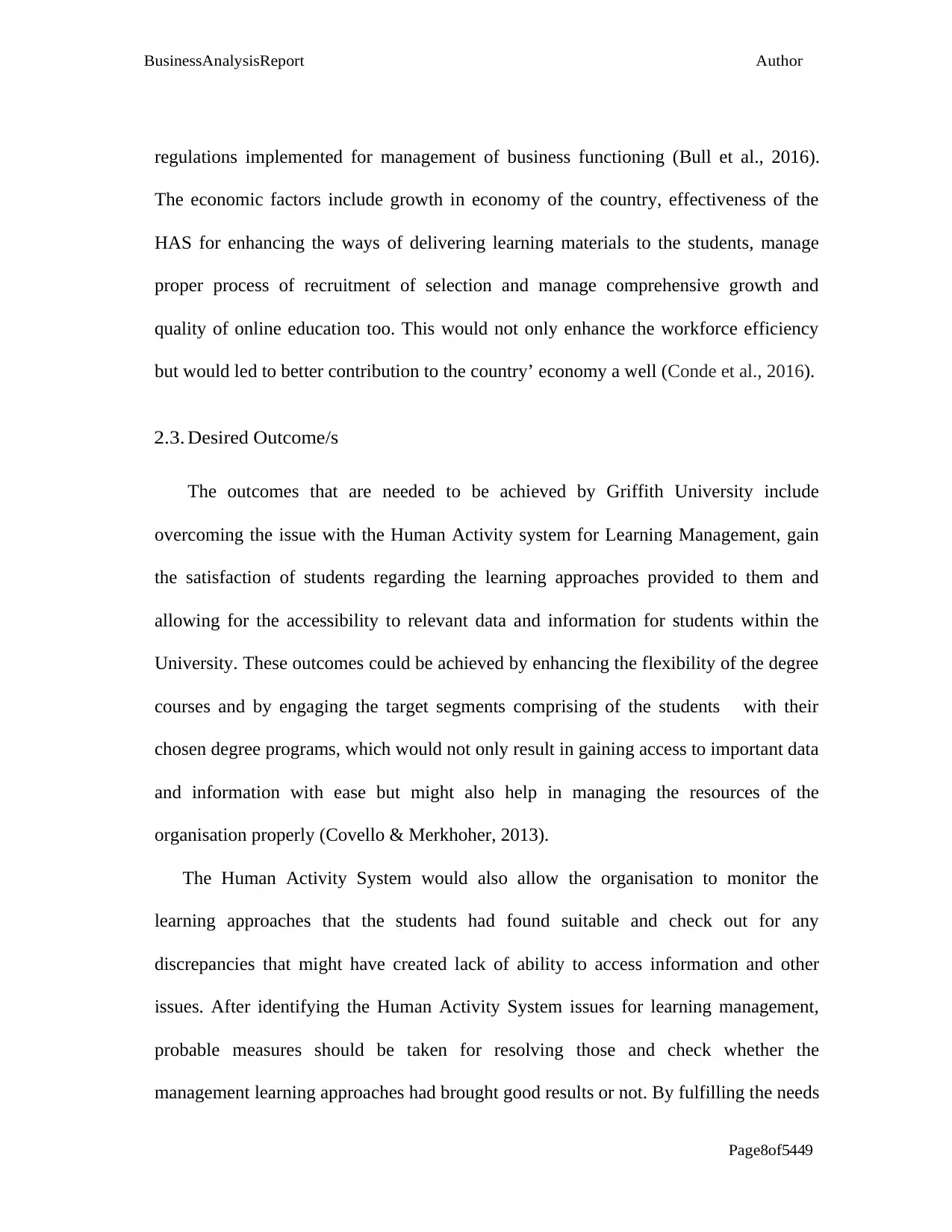
BusinessAnalysisReport Author
Page8of5449
regulations implemented for management of business functioning (Bull et al., 2016).
The economic factors include growth in economy of the country, effectiveness of the
HAS for enhancing the ways of delivering learning materials to the students, manage
proper process of recruitment of selection and manage comprehensive growth and
quality of online education too. This would not only enhance the workforce efficiency
but would led to better contribution to the country’ economy a well (Conde et al., 2016).
2.3. Desired Outcome/s
The outcomes that are needed to be achieved by Griffith University include
overcoming the issue with the Human Activity system for Learning Management, gain
the satisfaction of students regarding the learning approaches provided to them and
allowing for the accessibility to relevant data and information for students within the
University. These outcomes could be achieved by enhancing the flexibility of the degree
courses and by engaging the target segments comprising of the students with their
chosen degree programs, which would not only result in gaining access to important data
and information with ease but might also help in managing the resources of the
organisation properly (Covello & Merkhoher, 2013).
The Human Activity System would also allow the organisation to monitor the
learning approaches that the students had found suitable and check out for any
discrepancies that might have created lack of ability to access information and other
issues. After identifying the Human Activity System issues for learning management,
probable measures should be taken for resolving those and check whether the
management learning approaches had brought good results or not. By fulfilling the needs
Page8of5449
regulations implemented for management of business functioning (Bull et al., 2016).
The economic factors include growth in economy of the country, effectiveness of the
HAS for enhancing the ways of delivering learning materials to the students, manage
proper process of recruitment of selection and manage comprehensive growth and
quality of online education too. This would not only enhance the workforce efficiency
but would led to better contribution to the country’ economy a well (Conde et al., 2016).
2.3. Desired Outcome/s
The outcomes that are needed to be achieved by Griffith University include
overcoming the issue with the Human Activity system for Learning Management, gain
the satisfaction of students regarding the learning approaches provided to them and
allowing for the accessibility to relevant data and information for students within the
University. These outcomes could be achieved by enhancing the flexibility of the degree
courses and by engaging the target segments comprising of the students with their
chosen degree programs, which would not only result in gaining access to important data
and information with ease but might also help in managing the resources of the
organisation properly (Covello & Merkhoher, 2013).
The Human Activity System would also allow the organisation to monitor the
learning approaches that the students had found suitable and check out for any
discrepancies that might have created lack of ability to access information and other
issues. After identifying the Human Activity System issues for learning management,
probable measures should be taken for resolving those and check whether the
management learning approaches had brought good results or not. By fulfilling the needs
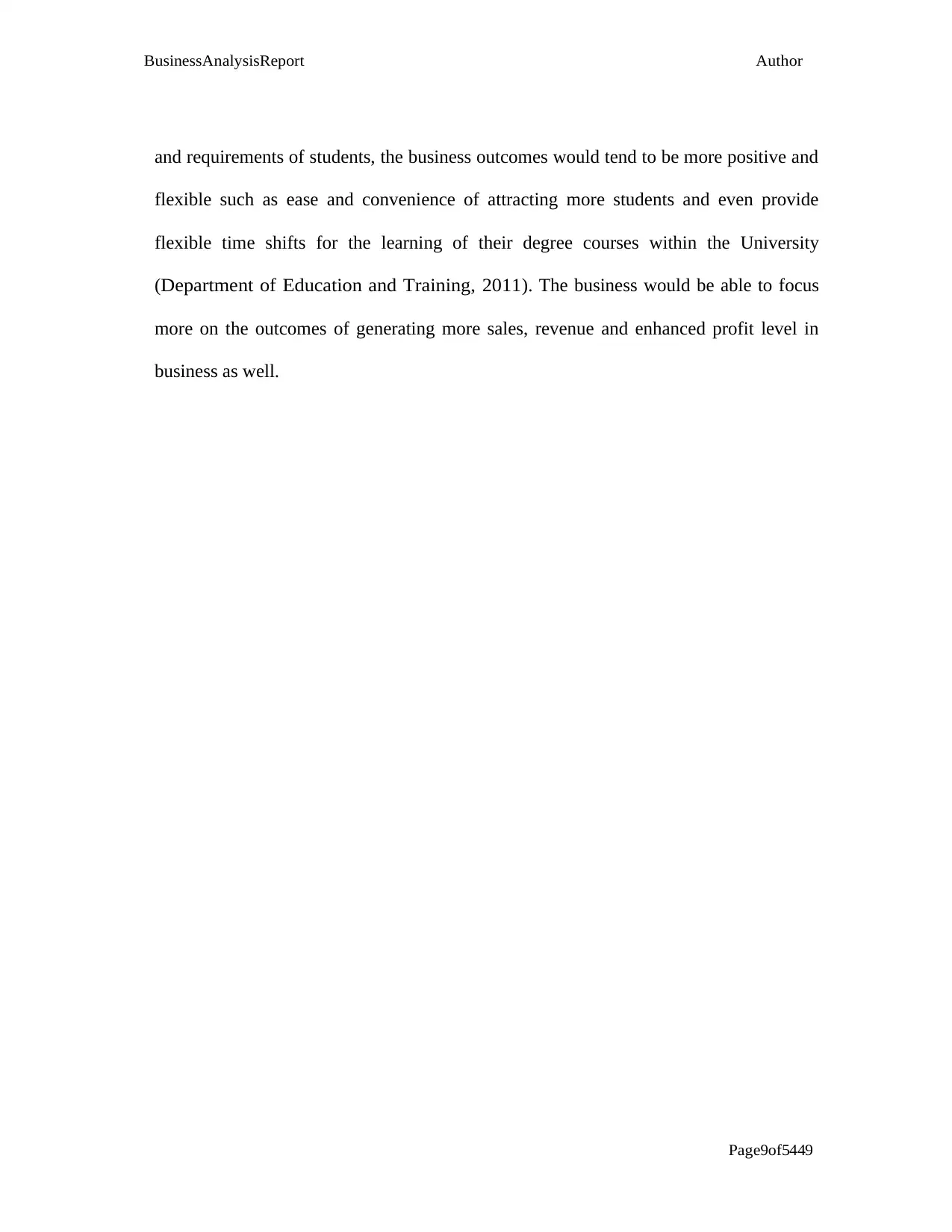
BusinessAnalysisReport Author
Page9of5449
and requirements of students, the business outcomes would tend to be more positive and
flexible such as ease and convenience of attracting more students and even provide
flexible time shifts for the learning of their degree courses within the University
( Department of Education and Training, 2011). The business would be able to focus
more on the outcomes of generating more sales, revenue and enhanced profit level in
business as well.
Page9of5449
and requirements of students, the business outcomes would tend to be more positive and
flexible such as ease and convenience of attracting more students and even provide
flexible time shifts for the learning of their degree courses within the University
( Department of Education and Training, 2011). The business would be able to focus
more on the outcomes of generating more sales, revenue and enhanced profit level in
business as well.
⊘ This is a preview!⊘
Do you want full access?
Subscribe today to unlock all pages.

Trusted by 1+ million students worldwide
1 out of 51
Related Documents
Your All-in-One AI-Powered Toolkit for Academic Success.
+13062052269
info@desklib.com
Available 24*7 on WhatsApp / Email
![[object Object]](/_next/static/media/star-bottom.7253800d.svg)
Unlock your academic potential
Copyright © 2020–2025 A2Z Services. All Rights Reserved. Developed and managed by ZUCOL.





